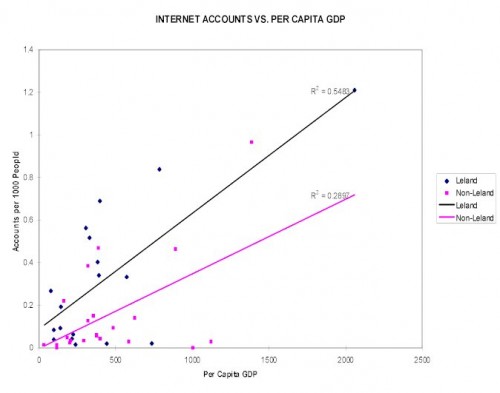The Leland Initiative

Comparison of Relationship Between Per Capita GDP and Internet Account per Capita in Leland Initiative and Non-Leland Initiative African Countries {cidcm.umd.edu/library/papers/jdaly/leland.html}
By today’s financial standards, USAID’s Leland Initiative looks minuscule. How far can US $15 million go to connect not one, but twenty nations over five years? Divide this sum up and each country is left with $150,000 per year. Still, the emphasis on local African content is impressive given the time period. The goals for the program, courtesy of the official USAID website, last updated in 2001, are far from simple:
- Improving connectivity within Africa
- Increasing access by Africans to people and information for sustainable development
- Enhancing African ability to find solutions to African problems
- Making African-produced information available to the world
Additionally, the Leland Initiative tailored its goals to each country’s economic, social, political, and educational needs. Perhaps most interesting is how the general initiative worked:
Q. What is the process that Leland uses to bring a typical country ‘on-board’?
A. First, Leland Washington receives an indication of interest from the USAID in-country Mission that Internet connectivity is desirable and feasible, for both the USAID Mission and the host country government.
Next, policy and technical experts review the telcom policy environment (Objective 1) and available telecommunications and Internet technologies (Objective 2) in the country. Generally, the assessments are conducted by a policy specialist from the State Department and an Internet technology specialist. During these visits, the specialists consult with US Embassy and USAID staff, host country telcom policy makers, state-owned and private sector telecommunications firms and e-mail firms. When host country and USAID resident officials determine it is appropriate, the LI negotiates a formal bilateral Memorandum of Understanding (MOU), signed by appropriate U.S. and host government officials. The MOU records the willingness of the host country to promote Internet friendly policies and the establishes the commitment of USAID to assist it to develop reliable high-speed access to the Internet.
In a typical country, with minimal Internet access, the next step is the development of a Plan of Action that details how the technology supplied by USAID (if any is needed) will be operated, maintained and Internet access made available to private sector Internet service providers. The Plan of Action normally addresses the following issues:
* A technical design for a national Internet gateway and dedicated access for private Internet Service Providers (ISPs);
* A cost-based tariff structure;
* A business and marketing plan for the gateway;
* An organizational structure for the gateway operating center;
* A training plan for gateway staff;
* A process and timeline for qualifying and licensing private sector ISPs;
* A plan for developing an Internet Society Chapter, to serve as a support and advocacy organization for the industry and users; and,
* Where feasible, a strategy and plan for expanding Internet access nation-wide, including secondary cities and rural villages.The Plan of Action is then implemented, including equipment acquisition and installation, training of staff, selection of private sector ISPs and the commissioning of the Internet gateway. Private sector Internet Service Providers are then able to gain access to the Internet gateway by dedicated leased lines, and retail Internet services to the public.
Q. How does the Leland Initiative Grow the User-Base?
The dynamism of growing the user-base (Objective 3) is addressed in two phases; they are not always in parallel with the supply side activities spelled out above. In Phase 1, the diagnostic and strategy Phase, Leland Information experts assess the Internet ‘readiness’ of the bilateral USAID field mission’s partners (eg – host country institutions, NGOs, other donors, etc.). The teams establish a priority list of “fast track” partners, those most ready to begin applying the information and communication tools of the Internet to the challenges of sustainable development, and prepare a list of pilot activities designed to demonstrate the value of Internet access.
The team then returns for Phase two, a process of training, brainstorming and detailed action planning with the Mission and its partners designed embed Internet tools throughout the portfolio. Over the course of the following year, Leland will assist the Mission and its partners to implement these action plans, and bring Internet use to full flower.
In addition, the LI will implement an analytical/research agenda focusing on pilot uses of the Internet to foster sustainable development and the collection and dissemination of information and lessons learned – the “best practices” – to decision-makers throughout the donor and host country communities.
From 1996-2001 the program made a world of difference in the ICT sector and set a precedent for foreign aid. In 1999, Mike Jensen determined that countries in which the Leland Initiative were active:
- may be less likely to have an ISP monopoly,
- appeared to have more ISPs, to have more Internet hosts per country, and
- had more Internet accounts.
A variety of websites still tout the goals and successes of the Leland Intiative:












 Twitter
Twitter Facebook
Facebook Pinterest
Pinterest